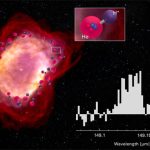“THE FACT THAT THE SIGNAL IS REPEATING AT SUCH A LEISURELY PACE IS EXTRAORDINARY.”
Key takeaways
- Scientists are puzzled by a repeated radio signal, ASKAP J1935+2148, which they think might be from a slow-spinning neutron star, but its slow spin raises many questions.
- The suspected source is a neutron star that rotates every 54 minutes, much slower than usual, making it the slowest known neutron star emitting radio waves.
- This object emits radio signals in three different states, each with unique properties, and these states change over time, suggesting physical changes in the emitting region.
- If it’s not a neutron star, it could be a white dwarf with a strong magnetic field, but no similar objects have been found nearby, adding to the mystery.
- Studying ASKAP J1935+2148 could lead to new insights about how neutron stars or white dwarfs emit radio waves and challenge current understanding of these stellar remnants.
Radio Star
Scientists are perplexed by a repeated radio signal from outer space since they are unable to adequately explain what is causing it.
Their working hypothesis, as outlined in a research published in the journal Nature Astronomy, is that the source is most likely a pulsar, a kind of neutron star that emits radio waves as it rotates on its axis.
However, if accurate, this raises even more issues. ASKAP J1935+2148, the slowest spinning neutron star yet observed, has a 54-minute interval. It’s so slow that it should be impossible, adding to a tiny but increasing list of seemingly inexplicable stellar remains.
“It is highly unusual to discover a neutron star candidate emitting radio pulsations in this way,” said research lead author Manisha Caleb of the University of Sydney Institute for Astronomy in a statement about the study. “The fact that the signal is repeating at such a leisurely pace is extraordinary.”
Speed Demon
Neutron stars arise in the aftermath of a supernova, which is an epic explosion that occurs when a large star runs out of fuel and collapses due to its own gravity.
Whatever material is not ejected into space is compressed into a fraction of the star’s initial size, making them the densest things in the universe that are not black holes.
Neutron stars also have extremely high magnetic fields, which propel streams of particles into space along their poles. When pulsars spin, these particle streams rotate as well, giving astronomers the impression that this is a repeating signal.
ASKAP J1935+2148 appears to match the criteria, however it’s unlikely that a neutron star can spin that slowly and yet emit pulses. To give you a sense of how unusual this is, pulsars usually complete a rotation in a matter of seconds, if that. Meanwhile, the fastest known neutron star spins at a staggering 716 times every second.
Stellar Spin-Off
The strange item also has three separate emission states, “each with properties entirely dissimilar from the others,” Caleb stated. There are powerful radio signals that last 10 to 50 seconds, followed by a lesser condition in which it produces a 26-times fainter pulse that lasts only a third of a second, and lastly a quiescent state.
Over the course of eight months, the researchers discovered that the active emission states were changing, implying that there may be physical changes in the region that is causing the emissions.
If it is not a neutron star, the researchers believe it might be a white dwarf, the most common sort of stellar remnant with a strong magnetic field. This option, however, raises questions: if the white dwarf is indeed magnetic, astronomers should have found others nearby due to their strength. But so yet, no one has been.
Further research of the item, Caleb stated, “might even prompt us to reconsider our decades-old understanding of neutron stars or white dwarfs; how they emit radio waves and what their populations are like in our Milky Way galaxy.”


